Apple's 2010 MacBook Air (11 & 13 inch) Thoroughly Reviewed
by Anand Lal Shimpi on October 26, 2010 10:08 PM EST- Posted in
- Mac
- Apple
- MacBook Air
- Laptops
The SSD: Not Half Bad
Apple advertises the new MacBook Air as being instant on as a result of the internal SSD. That’s mostly untrue. From a completely powered off state the MacBook Air still takes time to boot. That time is significantly reduced compared to the old MacBook Air and any other Mac with a conventional hard drive. It’s even a shorter boot than my MacBook Pro with a SandForce SF-1200 based SSD in it:
| System Performance Comparison | ||||||
| Boot | Shut Down | Sleep | Awake | |||
| 11-inch MacBook Air | 15.5 seconds | 2.2 seconds | 1.0 second | 1.63 seconds | ||
| 13-inch MacBook Air | 14.4 seconds | 1.9 seconds | 1.0 second | 1.56 seconds | ||
| 13-inch MacBook Air (Late 2008) | 34.4 seconds | 2.9 seconds | 1.6 seconds | 4.19 seconds | ||
| 15-inch MacBook Pro (SF-1200 SSD) | 19.1 seconds | 1.8 seconds | 1.5 seconds | 2.3 seconds | ||
| 15-inch MacBook Pro (Mid 2009, HDD) | 34.2 seconds | 2.8 seconds | 1.8 seconds | 2.1 seconds | ||
You'll notice that even the SF-1200 SSD in my 15-inch MacBook Pro takes longer to boot than these new Airs. Apple does customize the firmware on its SSDs. I’d be willing to bet the SSD in the MacBook Air has tight integration with OS X to guarantee quicker than normal boot times.
Clearly the new Air isn't instant on from a boot standpoint, but it's pretty much there from a recover-from-sleep standpoint. The new Airs both go to sleep and wake up from sleep quicker than any of the other Macs, including my upgraded 15-inch Core i7 MacBook Pro. Again, nothing can trump Apple's tight integration between hardware and software.
Apple likes to work with two different controller manufacturers for SSDs: Samsung and Toshiba. iFixit already confirmed Toshiba is in the new MacBook Air with its teardown:
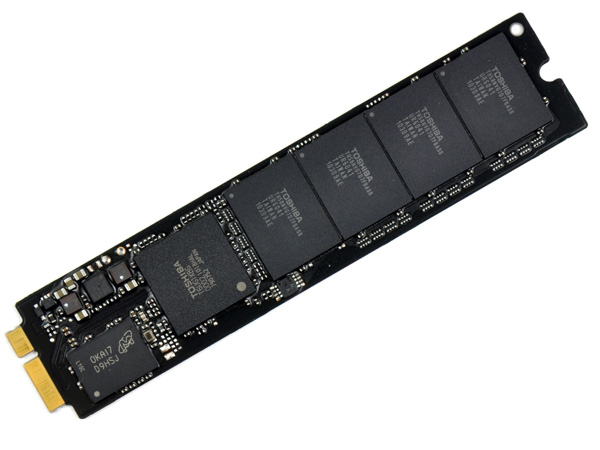
The 11-inch MacBook Air SSD, courtesy of iFixit
The SSD isn’t in an industry standard form factor, although the connector appears to be either micro or mini SATA. Presumably 3rd party SSD manufacturers (ahem, SandForce partners I’m looking at you) could produce drop in replacements for the MacBook Air SSD.
There’s nothing particularly innovative about the form factor of the SSD, other than Apple did away with the unnecessary space a 2.5” SSD would require. Just as SSDs will break the traditional SATA interface barriers, we’ll see the same happen to form factors as well.
The part number on the Toshiba controller may look familiar to some of you. It’s the same controller that’s in Kingston’s SSDNow V+ Series and the SSDNow V Series Boot Drive. I reviewed the latter not too long ago and found that it was a good drive for the money, and here’s the kicker: the SSDNow V Series Boot Drive was amazingly resilient when written to without TRIM support. Its performance hardly dropped as a result of normal desktop use. This is very important because although OS X 10.6.4 has a field for reporting TRIM support on an SSD, the instruction isn’t actually supported by the OS. Even the new MacBook Airs don’t ship with a version of OS X with TRIM support.
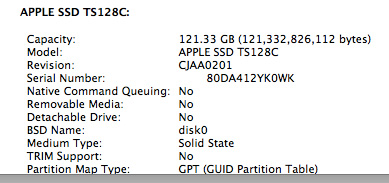
The SSD only has four NAND devices on it. Typically that would mean some very low transfer speeds, particularly on writes. But each one of those four devices has at least 16GB of NAND, spread across multiple planes and die. With the right firmware, you should be able to extract a good deal of parallelism from this architecture. Apple and Toshiba apparently do just that.

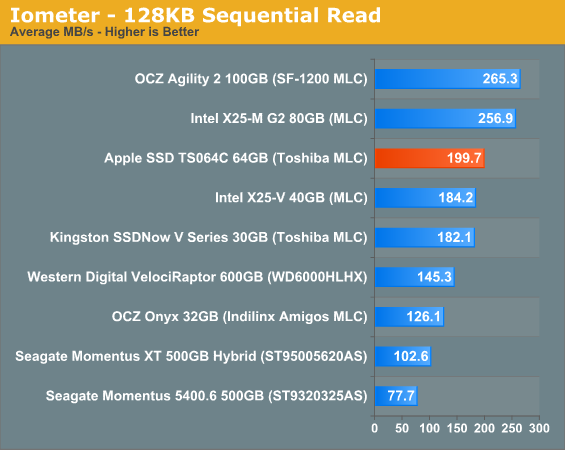
While most value SSDs top out at under 100MB/s, we get nearly 200MB/s sequential reads and writes out of the SSD in the new MacBook Air. And fortunately, Apple hasn’t only focused on sequential performance. The random read/write performance of the new MacBook Air SSD isn’t terrible:
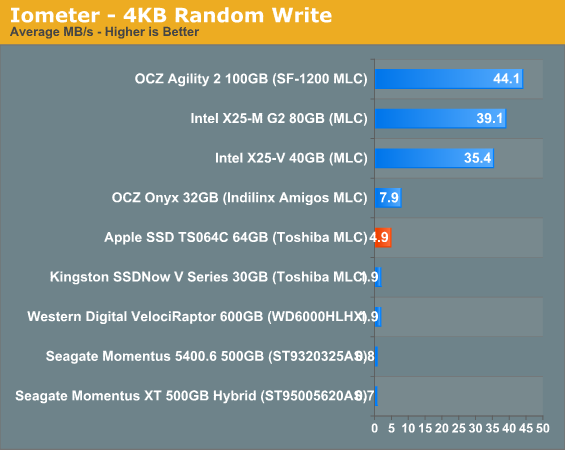
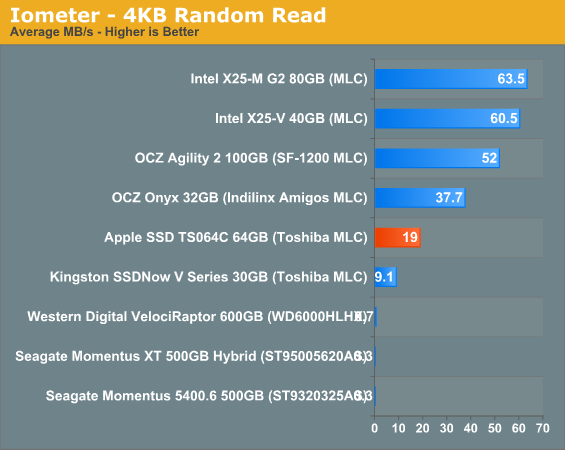
Random write performance is of course the weak point, but you’ll notice that it’s actually higher than the Kingston drive that uses the same controller. While Apple would’ve been better off striking a deal with Intel or SandForce for the controller in the MacBook Air, the Toshiba controller isn’t horrible.
As I mentioned earlier, resilience is very important as OS X still doesn’t support TRIM. I filled the drive with garbage and then tortured it for 20 minutes with random writes. The resulting performance drop was noticeable, but not unbearable:
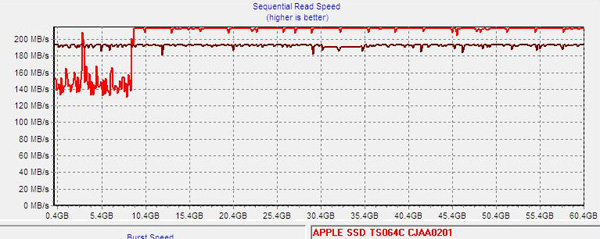
A single pass of sequential writes restores performance to normal:
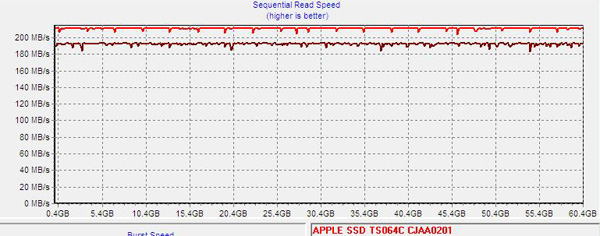
This tells us two things. First, through normal use the drive should be able to recover its performance over time (assuming you give it enough spare area). And second, if there’s any idle garbage collection in Apple’s custom firmware for the Toshiba controller it should be able to keep the drive running at peak performance even without TRIM supported in the OS. I don’t have a good way of measuring whether or not there’s GC enabled on the drive in OS X, but I suspect Apple is (at least it appears to be doing so on the Mac Pro’s SSDs).
Overall I’m pleased with Apple’s SSD selection. It could’ve been a lot better but it could’ve been a lot worse. The MacBook Airs in their default configuration have better IO performance than any other standard config Mac sold on the market today, including the Mac Pro.










185 Comments
View All Comments
JVC8bal - Wednesday, October 27, 2010 - link
Good case. Another example is Porsche, who has the widest profit margins of any car company. A 911 doesn't cost anything near what people will pay for them, and adding a $8,000 turbo doesn't equate to the $40,000 premium they can charge for it.ImSpartacus - Thursday, October 28, 2010 - link
Did you even bother reading the entire comment? I thought it was logical enough.A business is in the business of making money, not selling things. If a business can make more money by selling fewer things, they will do it.
quiksilvr - Wednesday, October 27, 2010 - link
I should have been clear:It will never happen because it makes to much sense to US. I'm not talking about the general unwashed masses that have an orgasm over an Apple Logo.
I'm talking about sensible people that would rather spend half as much for an ASUS Eee PC 1215N, or people that want luxury would get the HP Envy 14 or 17.
tno - Wednesday, December 29, 2010 - link
Wow. Sorry to kick up a dead thread, and I really hope I don't restart it. I just was really surprised by that comment. If you're kidding, maybe you're one of those griefers that says this stuff for kicks, then I guess that's your bag and you carry it, but seems silly to me. If you're serious, then you really have quite the glut of self esteem.My advice. Try it out. Want to keep your nose up? That's fine, don't buy one, just hackintosh a rig you've got. Don't game on it. Work on it. Read all the griefer blogs you want. Write on it. Produce something with it. I'm not an owner, yet, I'm a hackintosher. And having used XP, Win 7, Ubuntu and OS X on my netbook, laptop and desktop, OS X is my favorite platform to get work done, and the only one I would want to use on something with a screen smaller than 17".
If you give it a try and you still think Apple b10ws and you r001, fine. Us unwashed masses will just keep getting things done and loving every minute of it.
robco - Wednesday, October 27, 2010 - link
There's a few technical reasons why some of these things don't exist in the MBA. Apple can't use the iSeries chips in their low-end products because Intel has blocked third-party integrated graphics. The MBA doesn't have space for a discrete GPU. Intel's integrated graphics don't support OpenCL, something Apple intends to make use of going forward. USB 3.0 is a nice idea, but at the moment, requires a separate controller chip, something else there isn't room for. Hopefully either Intel will make decent graphics (I'm not holding my breath) or AMD will come out with a decent mobile CPU with better integrated graphics. I would imagine the microphone got moved because it wouldn't fit into the new, thinner display. Including an adapter isn't something that can be done at the factory - which would they include? Some folks will want VGA, some DVI, others might spring for the Cinema Display and not need it. As for the ExpressCard slot, I do with they remove the optical drive from the MB and MBP and add that, plus an extra USB port or two. I can count on one hand the number of times I've used an optical drive in the past four years.No offense, but I imagine Apple's engineers considered all these things and more. I looked at Windows laptops before getting my 15" MBP and good quality laptops are expensive no matter who makes them. I had a hard time finding anyone who could offer a fully featured notebook in a case less than an inch thin, with a high quality display, excellent battery life and rated EPEAT Gold. Apple just doesn't compete at the low end. By the time you take that $699 Windows laptops and start adding options, the price difference shrinks considerably.
softdrinkviking - Wednesday, October 27, 2010 - link
that's a very "can't do" kind of attitude.i really like apple's designs, but i really don't like the outdated processors they are using.
i refuse to believe that there is NOTHING that apple could do to bring better tech to it's fans.
it's very disappointing. :(
coldpower27 - Wednesday, October 27, 2010 - link
Well Apple wants to support a certain feature set, and they can't do so if they go Intel and their lackluster integrated Graphics. They want nVidia graphics.If they tried to add Intel's Westmere based products with Integrated Graphics it would become a 3 chip solution. They have done this for the 15/17 markets where the chasis can hold everything and the larger battery required.
On the 11/13 where space is premium it's integrated nVidia graphics, once Sandy Bridge rolls around, we may see that change....as Intel graphics is on the CPU itself.
tno - Wednesday, December 29, 2010 - link
This is exactly it. While Dell/Asus/Gateway churn out laptops designed to be able to fit whatever will be required of them from the next CPU/GPU/chipset, Apple chooses a set of function requirements and build their design out of that. The 11/13 size laptops are all about portability, so big batteries and thin designs at the expense of the newest, fastest processor. It's pertinent that when Dell decided to build an MBA competitor (the Adamo) they went with a rather similar specification, and ended up with worse battery life.So, could Apple sell a laptop for $600? Yep. It'd have a plastic chassis, carry whatever the cheapest processor they can squeeze out of Intel, the same crappy Clickpad everyone's slapping on their laptops, have a craptastic LCD, mediocre battery life and run Windows 7. Thanks, but no thanks. I'll go get a Mac.
OrionAntares - Wednesday, October 27, 2010 - link
Something about the MacBook Air and the processors. If they moved away from the Core 2 I'm pretty sure given the size constraints they'd need to stick with the Pentium and/or i3 ULVs. Making the Air thicker would be contrary to the whole point of the Air line. If you want a stronger processor (and more thickness) you'd go up to the regular Macbook line that is already thicker.JVC8bal - Wednesday, October 27, 2010 - link
I concur, this guy is a tard that doesn't know anything about systems engineering or manufacturing or "productizing".